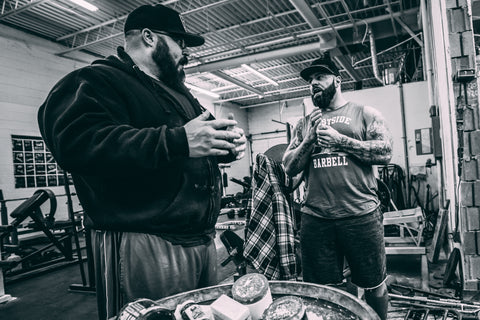Starting Conjugate: Adjusting DE Lower Training Percentages

The dynamic effort method is a cornerstone of Conjugate Method training. At Westside, the dynamic effort method is utilized to enhance explosive power, which is crucial in both strength and conventional sports. However, to be effective, dynamic effort training must be performed correctly.
Dynamic effort lower training days feature both a squat and deadlift main exercise. First, we execute the squat workout, then follow up with the deadlift. When performing a dynamic effort lower workout, there are specific training percentages and velocity requirements that must be met.
For athletes new to the Conjugate Method, the dynamic effort training days are where they encounter the most difficulty. First, the exercise must be set up correctly. With dynamic effort lower, this means that the accommodating resistance is appropriately applied, squat box height is correct, technical execution is on point, and barbell velocity meets the standard for both the squat and deadlift (.8m/s average velocity).
While it is relatively easy to learn how to properly set up accommodating resistance and the squat box, technical execution and barbell velocity is where most athletes run into issues. This is caused by too much focus on moving fast, leading to poor technical execution, or using training weight percentages that inhibit the athlete's ability to perform the movement at proper velocity.
Fortunately, both issues can be solved using one solution: lower the training percentages. If you are a member of the Conjugate Club, you have likely noticed we reduce dynamic effort training percentages at different points in the training. This ensures that all athletes can complete the dynamic effort exercises correctly regardless of ability level.
Below, we will discuss the basis of the standard dynamic effort lower training percentages and a few strategies to ensure all athletes can benefit from dynamic effort training.
Standard DE Lower Training Percentages
If you are already familiar with the Westside Barbell Conjugate Method, you likely know our standard DE lower training percentages throughout a three-week wave. In the first week, we will perform 12 sets of 2 reps at 75% (50% bar weight + 25% AR). In the second week, we perform 10 sets of 2 reps and escalate the training percentage to 80% (55% bar weight + 25% AR). In the third week, we perform 8 sets of 2 reps, escalating the training percentage to 85% (60% bar weight + 25% AR).
It is important to note that this wave scheme is incredibly effective and has produced incredible squats and deadlifts for both geared and raw powerlifters. However, advanced athletes who have spent much time under a barbell typically use these training percentages. If an athlete is relatively new to barbell training or has never used the Conjugate Method, attempting to train at these percentages can cause the athlete to run into some of the issues we discussed previously.
In this case, it only makes sense to manipulate the dynamic effort training by lowering training percentages and allowing the athlete to execute it properly. No matter how mentally tough an athlete is, training at unmanageable percentages is not sustainable and will disrupt the entire Conjugate Method training process. If I had to name the number one reason why athletes fail using the Conjugate Method, it would be using unmanageable dynamic effort training percentages.

Adjusted DE Lower Training Percentages
Once an athlete has reached a point where barbell velocity or technical execution becomes an issue during dynamic effort lower training, it is time to introduce an adjusted percentage scheme. It is important to note that adjusting dynamic effort training percentages is not a strategy reserved only for beginners or those new to the Conjugate Method. Even advanced athletes can benefit from using adjusted training percentages occasionally.
I have used the Conjugate Method for 16 years and have spent over half my life training. Even today, I will use an adjusted percentage scheme every few waves to keep training on point and account for accrued fatigue. Doing so ensures my dynamic effort training velocity meets the standard and avoids unnecessary injuries caused by improper technical execution.
When adjusting dynamic effort lower training percentages, we typically reduce them by 5%, but no more than 10%. For most athletes, the 5% reduction will make a significant difference. However, 10% can be necessary if an athlete is inexperienced or is dealing with fatigue-related issues.
Here's an example of a three-week training wave using adjusted DE lower training percentages.
Week 1: 12 sets of 2 reps, 70% (45% bar weight + 25% AR)
Week 2: 10 sets of 2 reps, 75% (50% bar weight + 25% AR)
Week 3: 8 sets of 2 reps, 80% (55% bar weight + 25% AR)
Notice that the accommodating resistance percentage remains at 25% each week. However, if this initial adjustment does not alleviate issues with barbell velocity or technical execution, we can then adjust the accommodating resistance as well:
Week 1: 12 sets of 2 reps, 65% (45% bar weight + 20% AR)
Week 2: 10 sets of 2 reps, 70% (50% bar weight + 20% AR)
Week 3: 8 sets of 2 reps, 75% (55% bar weight + 20% AR)
If reducing the barbell weight percentage by 5% does not work at first, it is almost guaranteed the 5% reduction in barbell weight coupled with the 5% reduction in accommodating resistance will. Remember, the goal is to eventually develop the capability to adhere to the standard dynamic effort lower training percentages. We want to make slight adjustments to the barbell weight before adjusting both the barbell weight and accommodating resistance.

Simple Adjustments for Improved Training Results
The Conjugate Method is the perfect strength training method for all individuals, regardless of the athlete's chosen sport. Whether you are a geared powerlifter, raw powerlifter, strongman competitor, football player, track and field athlete, or a golfer, the Conjugate Method will help take athletic performance to the next level. However, there will inevitably come a time when simple adjustments will need to be made to keep training productive.
As an athlete, when you reach the point where an adjustment needs to be made, always focus on making a slight adjustment rather than a drastic one. We want each adjustment to be just enough to improve the quality of training while still allowing a coach or athlete to discern whether or not the adjustment is delivering the desired training result.
Too often, individuals make drastic adjustments to their training plan, providing training data that can be difficult to interpret. If you make drastic or multiple adjustments simultaneously, it becomes difficult to say if the adjustment was ideal or effective. We always want training to be as optimized and productive as possible, so keep your adjustments to training simple and easy to track.
Always remember that when using dynamic effort, it is infinitely better to train too fast than too heavy. Adding some weight to the bar to reach adequate velocity is much easier than restructuring training to account for excess fatigue.
Check out our Starting Conjugate series for more information regarding the Conjugate Method.
Sources:
Simmons, L. (2007). Westside Barbell Book of Methods. Westside Barbell.
Verkhoshansky, Y., & Siff, M. C. (2009). Supertraining. Verkhoshansky.





